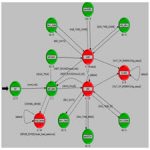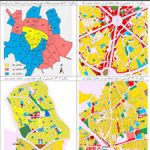توضیحات
ABSTRACT
Development of smart city has been increasingly accepted as a new technology-based solution to itigate urban diseases. The Chinese government has been devoting good efforts to the promotion of smart city through introducing a series of policies. However, policies may have limited effectiveness in application if they do not respond to the practice. There is little study examining what results have been achieved in practice by applying policy measures. This study presents a holistic evaluation of smart city performance in the context of China. The evaluation indicators in this study are selected by applying a hybrid research methodology including literature review and semi structured interviews. Indicator data are collected from 44 sample smart cities. The evaluation was conducted by applying Entropy method and Technique for Order Preference by Similarity to Ideal Solution (TOPSIS) technique collectively. This study highlights that the overall smart city performance in China is at a relatively low level. There is also a significant unbalance in performance between five smart city dimensions including smart infrastructure, governance, people, economy and environment. The smart performance between cities varies significantly since cities implement smart city programs in different ways. These differences impede experience sharing between cities. Actions have been recommended in this study for promoting further development of smart city in the context of China, such as increasing the investment on smart infrastructure, providing training programs, and establishing evaluation mechanism.
INTRODUCTION
According to the World Development Indicators (WDI) database issued by World Bank, the proportion of urban population reached to 53.857% in 2015 (World Bank, 2017), and this figure was predicted to reach to 60% by 2030 (United Nations, 2015). In particular, it was suggested that this figure would increase significantly in those developing countries such as China. In China, the urban population increased from 22% in 1980s to 57.35 % in2016 (National Bureau of Statistics of PRC, 2016). However, it is widely appreciated that rapid urbanization has generated many problems usually called “urban diseases”, such as energy shortage, environment pollution, traffic congestion, social inequality, unavailability or shortage of public service, and land loss (Neirotti et al., 2014; Chen, 2007; Cui & Shi, 2012). These problems make cities disordered and unorganized, and hamper the growth of cities (Johnson, 2008). In searching for solutions to address these problems, smart city has been introduced as a new technology-driven mechanism (Eger, 2003; Coe et al., 2001; Hollands, 2008; Lee et al, 2014).
چکیده
توسعه شهر هوشمند به طور فزاینده ای به عنوان یک راه حل مبتنی بر فناوری جدید برای تسکین بیماری های شهری پذیرفته شده است. دولت چین، از طریق معرفی یک سری سیاست ها، تلاش های خوبی را برای ارتقای شهر هوشمند انجام داده است. با این وجود، ممکن است سياست ها در مورد كارآيي كارآيي محدودي داشته باشند، اگر به عمل پاسخ ندهند. مطالعات کمی وجود دارد که بررسی نتایج حاصل از عملکردهای سیاسی را به دست می دهد. این مطالعه ارزیابی جامع از عملکرد شهر هوشمند در چين را ارائه می دهد. شاخص های ارزیابی در این مطالعه با استفاده از یک روش تحقیق ترکیبی از جمله بررسی ادبیات و مصاحبه نیمه ساختاری انتخاب شده اند. داده های شاخص از 44 نمونه شهرهای هوشمند جمع آوری شده است. ارزيابي با استفاده از روش آنتروپي و تكنيك براي ترجيح سفارش با استفاده از روش شبيه سازي ايده آل (TOPSIS) انجام گرديد. این مطالعه نشان می دهد که عملکرد کل شهر هوشمند در چین در سطح نسبتا پایین است. همچنین اختلاف قابل توجهی در عملکرد بین پنج ابعاد شهر هوشمند از جمله زیرساخت هوشمند، حکومتداری، مردم، اقتصاد و محیط زیست وجود دارد. عملکرد هوشمندانه بین شهرها به طرز چشمگیری متفاوت است زیرا شهرها برنامه های شهر هوشمند را به روش های مختلفی اجرا می کنند. این تفاوت ها مانع از اشتراک تجربه بین شهرها می شود. اقدامات در این مطالعه برای ارتقای توسعه شهر هوشمند در زمینه چین توصیه شده است، مانند افزایش سرمایه گذاری در زیرساخت هوشمند، ارائه برنامه های آموزشی و ایجاد سازوکار ارزیابی.
مقدمه
با توجه به داده های شاخص توسعه جهانی (WDI) که توسط بانک جهانی منتشر شده است، نسبت جمعیت شهری در سال 2015 به 53.857٪ رسیده است (بانک جهانی، 2017) و این رقم پیش بینی شده تا سال 2030 به 60٪ برسد (سازمان ملل، 2015 ) به طور خاص، پیشنهاد شد که این رقم در کشورهای در حال توسعه مانند چین افزایش یابد. در چین، جمعیت شهری از 22 درصد در سال 1980 به 57.35 درصد در سال 2016 افزایش یافته است (Bureau of National Statistics of PRC، 2016). با این حال، به طور گسترده ای قدردانی می شود که شهرنشینی سریع باعث مشکلات زیادی شده که معمولا “بیماری های شهری” نامیده می شود، مانند کمبود انرژی، آلودگی محیط زیست، ترافیک، نابرابری اجتماعی، عدم دسترسی یا کمبود خدمات عمومی و از دست رفتن زمین (Neirotti et al. 2014؛ چن، 2007؛ Cui & Shi، 2012). این مشکلات باعث ایجاد اختلال در شهرها و عدم سازماندهی آنها می شود و مانع رشد شهرها می شود (جانسون، 2008). در جستجوی راه حل هایی برای حل این مشکلات، شهر هوشمند به عنوان مکانیسم جدید فن آوری مبتنی بر فناوری معرفی شده است (Eger، 2003؛ Coe et al.، 2001؛ Hollands، 2008؛ Lee et al.، 2014).
Year: 2018
Publisher : ELSEVIER
By : Liyin Shen , Zhenhua Huang, Siu Wai Wong, Shiju Liao, Yingli Lou
File Information: English Language/ 54 Page / size: 1.02 MB
سال : 1396
ناشر : ELSEVIER
کاری از : لیین Shen، Zhenhua هوانگ، Siu Wai Wong، Shiju Liao، Yingli لو
اطلاعات فایل : زبان انگلیسی / 54 صفحه / حجم : MB 1.02










نقد و بررسیها
هنوز بررسیای ثبت نشده است.